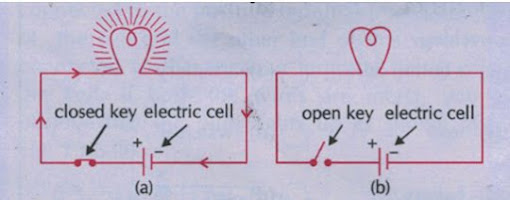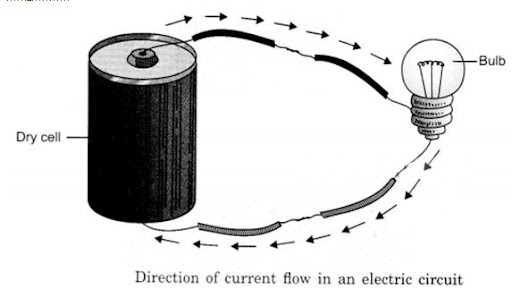electricity and circuit, class 6
Electricity class 6
·
Electricity
is useful form of energy. it play very important role in our daily life it make
our work easy.
·
It
is needed for functioning of electric equipments like computer refrigerator air
conditioner bulb and etc
Electric
cell:
It is a common source of electric energy for many types of equipment it
is used in calculators .remote, toy , camera etc
Advantage
of electric cell
- ·
They
are lightweight so they are portable
- ·
they
produce a very small amount of electricity so safe for work
- ·
they
are not very costly
- ·
they
do not contain chemical liquid
- ·
they
give study electric current
Dry cell: Dry cell is a source of electricity. it
convert chemical energy into electric
energy. A dry cell is a very convenient source of electric current
A cell consist of an outer covering made up of
zinc at the centre of container a carbon rod with a metallic cap made of brass
is placed .this carbon rod is surrounded
by mixture of magnesium dioxide and powder charcoal (carbon), the remaining
space inside zinc container is filled with thick paste of ammonium chloride NH4Cl.
the outer side of the zinc container is covered with cardboard and the base of
zinc remain uncovered. the metallic cap act as positive terminal (+ve)and base
of zinc container act as negative terminal(-ve).
- ·
dry cell is
used in electrical clock, toys
- ·
button cell is
used in watch.
- ·
Solar panels
made up of solar cells are used to light up streets and many homes.
Battery : When
two or more cells are connected and to and they form battery
Bulb: An electric bulb is a device which glows and emits
light, when electric current is passed through it. So convert electric energy
into light energy.
Bulb contain a thin tiny wire (made up of tungsten) inside the glass cover. This is called filament. It is supported by two thicker wires, as shown in Fig. One of these thick wires is connected to the metal casing around the base of’the bulb. The other is connected to the metal tip of the base. The base of the bulb and the metal tip of the base are the two terminals of the bulb. These two terminals are fixed in such a way that they do not touch each other.
The inside portion of the bulb is filled up with
inert gases, like argon.
When
an electric current is pass through the filament of bulb the filament become
hot and emits light
fused bulb: If the filament of the bulb is broken,
the circuit is not corhpleted and hence the current cannot flow. The bulb with
broken filament is called a fused bulb. When a bulb gets fused, it does not
light up.
Circuit: The complete path,
from one terminal of the electric cell through the bulb and back to the other
terminal of the electric cell, is called a circuit.
Open circuit: If there is any
gap in the path of a circuit, the bulb does not light up. Such a circuit is
called an open circuit.
Closed circuit: The bulb lights up
only when a bulb and wire form a complete path, which starts at one terminal of
electric cell and ends at the other terminal. Such a circuit is called a closed
circuit.
Electric current: the rate of flow of charge is known as current.
Electric switch: Electric switch is a simple device that either breaks the
circuit or completes it to stop or start the flow of current.
·
When the switch completes the circuit, it is called closed
switch.
·
When the switch breaks the circuit, it is called open switch.
flow of
current in a circuit: As soon as the path from one terminal of
electric cell to the other is completed, an electric current starts flowing
through the circuit and the bulb lights up. The electric current flows from the
positive terminal of the electric cell to its
negative
terminal.
·
A device used to produce an electric current like cell, battery,
or a plug point acting as a source.
·
A wire made of a metal like copper, silver, or aluminium, which
will allow electric current to flow through easily.
·
An unbroken loop (of the wire) running from one terminal of the
source, through various appliances, back to the other terminal of the source.
Making a Simple Electric
Circuit:
When we connect the terminals of a pencil cell (name given to the cell due to
its shape) to a bulb using two wires, the bulb glows. This happens because we
provide a path for the current to flow. A path for an electric current to flow
is called an electric circuit.
·
·
In Figure 14.6(a), one wire from the pencil cell is connected to
the torch bulb, while the other wire is not. The electric circuit is not
complete here. In Figure 14.6(b), both the wires from the cell are connected to
the torch bulb. The electric circuit is complete in this case. Electric current
flows only if there is an unbroken path or closed circuit starting from one
terminal of the source, through the torch bulb, to the other terminal of the
source. Thus, the bulb glows in Figure 14.6(b) but not in Figure 14.6(a). The
circuit in Figure 14.6(a) is not complete. Hence, current cannot flow through
the circuit and the bulb does not glow. Such a circuit is called an open
circuit. The circuit in Figure 14.6(b) is complete. Electric current flows
through the circuit and, as a result, the bulb glows. Such a circuit is called
a closed circuit.
A schematic diagram of an electric torch is
shown in Fig. An electric torch has one or more dry cells inside it, which act
as the ‘source’. These cells are connected through a switch to a small bulb.
When the switch is pushed to the ‘on’ position, the circuit is complete and the
bulb glows. When the switch is pushed to the ‘off’ position, the circuit is
incomplete (broken). Now the current cannot flow through the circuit, and the
light goes out.
There
are 3 metal strips- metal strip (A part
of switch) metal strip B (connected to the metal case) metal strip C (connected
to the spring ) meta strip B and C are fixed while metal strip a is pressed and
made two slide
when
the switch is pushed to on position the
metallic strip A is pushed forward so that it touches B and C and the circuit is complete which glow the
bulb. when the switch is supposed to off the contact between strip a and b
broke and the circuit broke do not glow bulb.
Conductors
·
Materials through which electric current can flow are called
conductors.
·
Most metals are conductors.
·
Our body is also a good conductor.
Insulators
·
Materials, through which the electric current cannot pass, are
called insulators. In other words, insulators are the bad conductors of
electricity.
·
Rubber and wood are insulators.
Electrical safety:
A
person may get an electric shock because our body is a good conductor of
electricity. some preventive measures to avoid electric shock are as follows:
- 1. replace
the light bulb only when it is switched off and cool
- 2. never
touch electrical switches or gadgets
when your body is wet( water is good conductor of electricity)
- 3. don't
try to repair or install electrical wiring or appliance
- 4. do
not touch electric poles and transformers on the road
- 5. do
not touch hanging wire on the road
- 6. never
fly kites near overhead power line
- 7. never
join the electric wires with bare hands












Comments
Post a Comment